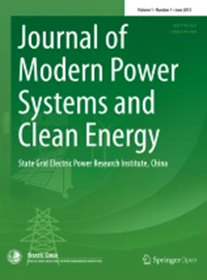Reinforcement Learning- and Option-Jointed Modeling for Cross-Market and Cross-Time Trading of Generators in Electricity and Carbon Markets
IF 6.1
1区 工程技术
Q1 ENGINEERING, ELECTRICAL & ELECTRONIC
Journal of Modern Power Systems and Clean Energy
Pub Date : 2024-10-22
DOI:10.35833/MPCE.2024.000013
引用次数: 0
Abstract
With the development of the carbon markets (CMs) and electricity markets (EMs), discrepancies in prices between the two markets and between two time periods offer profit opportunities for generation companies (GenCos). Motivated by the carbon option and Black-Scholes (B-S) model, GenCos are given the right but not the obligation to trade carbon emission allowances (CEAs) and use instruments to hedge against price risks. To model the strategic behaviors of GenCos that capitalize on these cross-market and cross-time opportunities, a multi-market trading strategy that incorporates option-jointed daily trading and reinforcement learning-jointed weekly continuous trading are modeled. The daily trading is built with a bi-level structure, where a profit-oriented bidding model that jointly considers both the optimal CEA holding shares and the best bidding curves is developed at the upper level. At the lower level, in addition to market clearing models of the day-ahead EM and auction-based CM, a B-S model that considers carbon trading asynchronism and option pricing is constructed. Then, by expanding the daily trading, the weekly continuous trading is modeled and solved using reinforcement learning. Binary expansion and strike-to-spot price ratio are utilized to address the nonlinearity. Finally, case studies on an IEEE 30-bus system are conducted to validate the effectiveness of the proposed trading strategy. Results show that the proposed trading strategy can increase GenCo profits by influencing market prices and leveraging carbon options.电力和碳市场中发电机跨市场、跨时间交易的强化学习和期权联合建模
随着碳市场(CMs)和电力市场(EMs)的发展,两个市场之间和两个时间段之间的价格差异为发电公司(GenCos)提供了盈利机会。在碳期权和布莱克-斯科尔斯(B-S)模型的激励下,发电公司被赋予了交易碳排放配额(CEAs)和使用工具对冲价格风险的权利,而不是义务。为了模拟发电公司利用这些跨市场和跨时间机会的战略行为,我们建立了一个多市场交易策略模型,该策略包含期权联合每日交易和强化学习联合每周连续交易。每日交易采用双层结构构建,其中上层建立以利润为导向的竞价模型,同时考虑最优东航持股和最优竞价曲线。在较低层次上,除了日前EM和拍卖CM的市场出清模型外,构建了考虑碳交易异步性和期权定价的B-S模型。然后,通过扩展日交易,对周连续交易进行建模,并使用强化学习进行求解。利用二元展开和行权-现货价格比来解决非线性问题。最后,在IEEE 30总线系统上进行了案例研究,以验证所提出的交易策略的有效性。结果表明,所提出的交易策略可以通过影响市场价格和利用碳期权来提高发电公司的利润。
本文章由计算机程序翻译,如有差异,请以英文原文为准。
求助全文
约1分钟内获得全文
求助全文
来源期刊

Journal of Modern Power Systems and Clean Energy
ENGINEERING, ELECTRICAL & ELECTRONIC-
CiteScore
12.30
自引率
14.30%
发文量
97
审稿时长
13 weeks
期刊介绍:
Journal of Modern Power Systems and Clean Energy (MPCE), commencing from June, 2013, is a newly established, peer-reviewed and quarterly published journal in English. It is the first international power engineering journal originated in mainland China. MPCE publishes original papers, short letters and review articles in the field of modern power systems with focus on smart grid technology and renewable energy integration, etc.
 求助内容:
求助内容: 应助结果提醒方式:
应助结果提醒方式:


